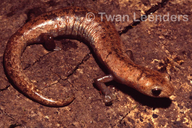|
Bolitoglossa lignicolor (Peters, 1873)
Subgenus: Bolitoglossa | family: Plethodontidae subfamily: Hemidactyliinae genus: Bolitoglossa |
 © 2007 Twan Leenders (1 of 12) |
|
|
|
Description Adults are 76 to 160 mm in total length. Adult males are 47 to 68 mm in standard length, while adult females are 46 to 81 mm in standard length. Tail length is moderate, ranging from 45% to 51% of total length. Eyes are also moderate and slightly protuberant. Adults have 27 to 48 maxillary teeth, and 22 to 40 vomerine teeth. In males, there are 2 to 3 1/2 costal folds between adpressed limbs, while in females, there are 2 1/2 to 4 costal folds. Hands and feet are fully webbed. Webs are thick and digits are not very flattened. No subterminal pads are present. Head width is 14 to 18% of standard length. In adult males, leg length is 22 to 26% of standard length, and in females, leg length is 21 to 24% (Brame and Wake 1963). Color is variable. Flanks and venter are dark chocolate and usually sharply separated from the broad dorsal cream to tan field. Dorsal field is unmarked in juveniles but in adults, it usually has dark brown streaks or washes. Some adults are uniform dark brown or have only a few streaks of light color. Venter is a uniform dark brown in juveniles; in adults the venter is usually marked with large light spots (Savage 2002). Distribution and Habitat Country distribution from AmphibiaWeb's database: Costa Rica, Panama
Life History, Abundance, Activity, and Special Behaviors Trends and Threats Possible reasons for amphibian decline General habitat alteration and loss Comments A Spanish-language species account can be found at the website of Instituto Nacional de Biodiversidad (INBio).
References
Koehler, G., Sunyer, J., Ponce, M., and Batista, A. (2008). ''Noteworthy records of amphibians and reptiles in Panama (Amphibia: Plethodontidae, Craugastoridae, Hylidae; Reptilia: Polychrotidae).'' Senckenbergiana Biologica, 88, 329-333. Brame, A. H., and Wake, D. B. (1963). ''Redescription of the plethodontid salamander Bolitoglossa lignicolor (Peters), with remarks on the status of B. palustris Taylor.'' Proceedings of the Biological Society of Washington, 76, 289-296. Ibañez, R., Solís, F., Jaramillo, C. and Rand, S. (2000). ''An overview of the herpetology of Panama.'' Mesoamerican Herpetology: Systematics, Zoogeography and Conservation. Johnson, J. D., Webb, R. G. and Flores-Villela, O. A., eds., The University of Texas at El Paso, El Paso, Texas, 159-170. Savage, J. M. (2002). The Amphibians and Reptiles of Costa Rica:a herpetofauna between two continents, between two seas. University of Chicago Press, Chicago, Illinois, USA and London. Stuart, S., Hoffmann, M., Chanson, J., Cox, N., Berridge, R., Ramani, P., Young, B. (eds) (2008). Threatened Amphibians of the World. Lynx Edicions, IUCN, and Conservation International, Barcelona, Spain; Gland, Switzerland; and Arlington, Virginia, USA. Originally submitted by: David Chen (first posted 2009-11-02) Edited by: Kellie Whittaker (2010-04-19) Species Account Citation: AmphibiaWeb 2010 Bolitoglossa lignicolor <https://amphibiaweb.org/species/3984> University of California, Berkeley, CA, USA. Accessed May 30, 2025.
Feedback or comments about this page.
Citation: AmphibiaWeb. 2025. <https://amphibiaweb.org> University of California, Berkeley, CA, USA. Accessed 30 May 2025. AmphibiaWeb's policy on data use. |



 Raffaëlli Account
Raffaëlli Account Map of Life
Map of Life